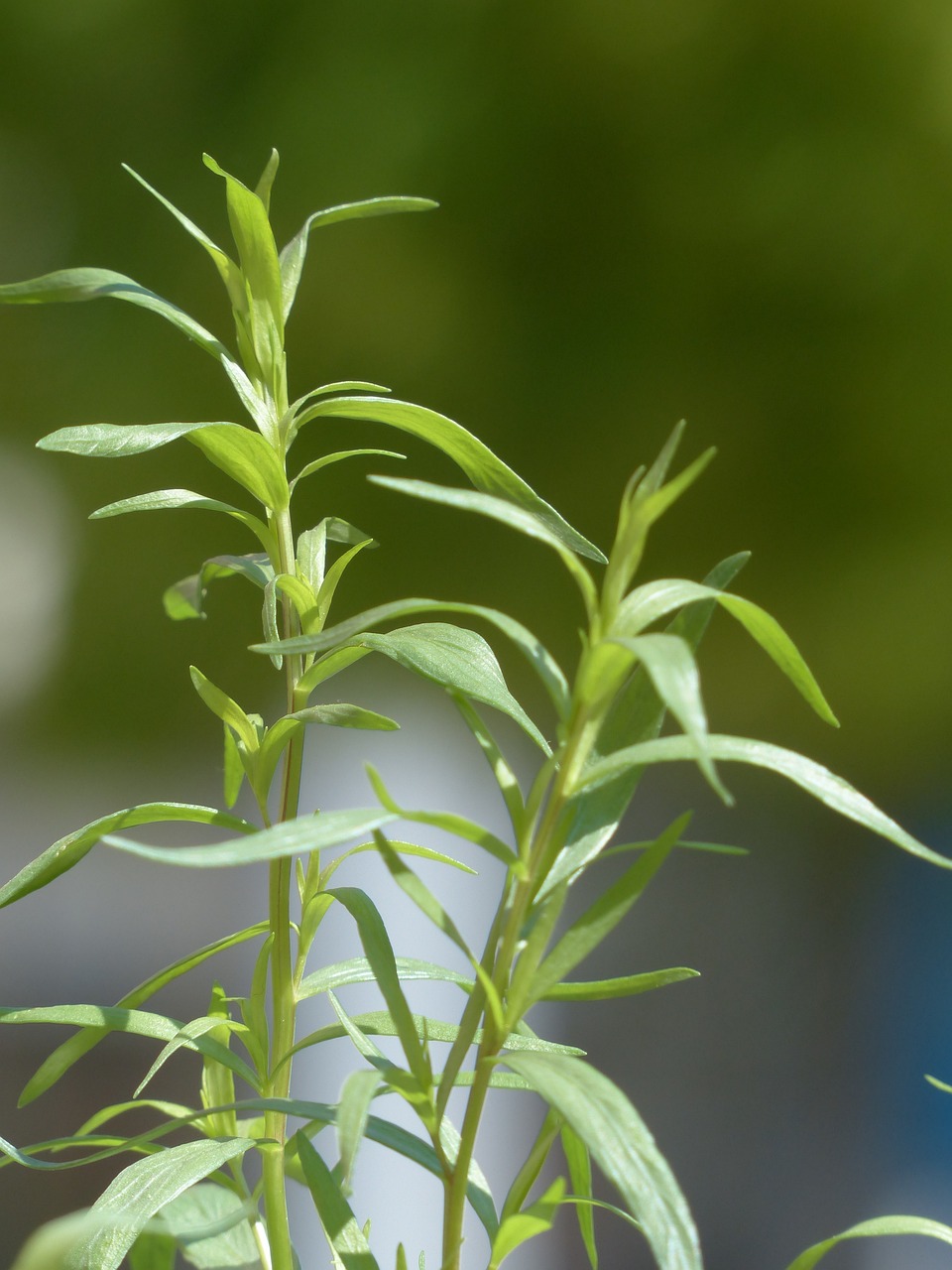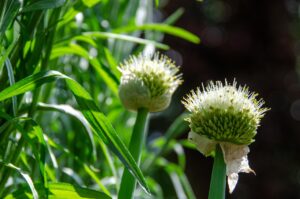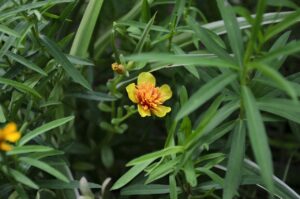Tarragon
Overview
Tarragon is a perennial herb basking in the limelight of French cuisine for its anise-like savor. With slender green leaves and tiny flowers, this plant relishes sunny spots with well-drained soil. A staple in culinary gardens, tarragon complements chicken, seafood, and eggs, and is favored for its robust flavor and aromatic leaves. It’s easy to grow, enjoys a sunny disposition, and brings perennial joy to dishes and gardens alike.

Characteristics
Known for its anise-like flavor, perennial growth, and prominence in French cuisine.
Region
Tarragon is commonly grown in temperate regions, especially across North America and Eurasia.
Natural Habitat
Tarragon is usually found in grasslands and in light, dry places in its native habitats.
Cultivation
Prefers full sun exposure, even moisture without waterlogging, and well-drained soil.
Uses and Benefits
Step into the kitchen, and let tarragon unlock a world of flavor for you. This herb, with its distinctive anise-like taste, is a crown jewel in French culinary tradition. Imagine the finesse it brings to delicate seafood dishes, the subtle elegance it adds to creamy egg recipes, and the aromatic lift it offers to a roast chicken. Not to mention, it makes a bright, licorice-kissed companion to tomatoes, transforming the humble into haute cuisine.4
But tarragon isn’t just a one-trick pony confined to the realms of gastronomy. Artemisia dracunculus, or French tarragon, with its superior taste and tender texture, stands apart from its Russian cousin, favored for adding that je ne sais quoi to dishes1. Whether drizzled over gourmet fare or mixed into everyday meals, tarragon’s versatile flavor is something that both novices and seasoned chefs treasure alike.
Beyond its culinary prowess, tarragon also boasts a range of potential health benefits. This fragrant herb is:
- Rich in antioxidants: Tarragon contains compounds that help combat oxidative stress and inflammation in the body.
- A digestive aid: Its essential oils may help stimulate digestion and alleviate digestive discomfort.
- A potential sleep enhancer: Some studies suggest that tarragon may help improve sleep quality.
- An immune booster: The herb’s antimicrobial properties could help support the immune system.
So, whether you’re looking to elevate your cooking game or simply hoping to incorporate more health-promoting herbs into your diet, tarragon is a fantastic choice. Its unique flavor profile and impressive nutritional properties make it a must-have in any herb garden or kitchen pantry.

Cultivation Tips
To ensure your tarragon thrives, planting it in a sun-kissed spot with well-drained soil is key1. This herb doesn’t take kindly to overwatering or soggy conditions, so aim for a balanced approach when it comes to moisture. Keep in mind that tarragon prefers a temperate climate and may struggle in areas with extreme heat or humidity3.
While tarragon is a perennial that comes back with fresh growth each year, it does require some room to spread out via its underground rhizomes3. If you find your tarragon expanding a bit too enthusiastically, consider dividing the plant every few years to keep it in check and maintain its health. When selecting tarragon for your culinary endeavors, opt for the French variety over the Russian one – it’s the top choice among gourmet chefs for its sweet, aromatic flavor that adds a delightful French flair to your dishes1.
- Sun and soil: Plant tarragon in a sunny location with well-draining soil.
- Water: Avoid overwatering, as tarragon doesn’t tolerate soggy conditions well.
- Climate: Tarragon prefers temperate climates and may not thrive in extreme heat or humidity.
- Spread: Allow space for tarragon to spread through its underground rhizomes.
- Maintenance: Divide the plant every few years to control its growth and maintain its health.
- Variety: Choose French tarragon (Artemisia dracunculus var. sativa) for the best flavor in culinary applications.
Seasonal Considerations
To keep your tarragon flourishing, it’s essential to find a spot in your garden that receives plenty of sunlight and has well-draining soil1. This herb is sensitive to overwatering and doesn’t appreciate soggy roots, so strike a balance when it comes to moisture. Tarragon also has a preference for milder temperatures and can struggle in intense heat or humidity3.
As a perennial, tarragon will grace your garden with fresh growth each year, but it’s important to give it room to stretch out. Tarragon spreads through underground rhizomes3, so it can expand over time. If you find it encroaching on its neighbors, consider dividing the plant every few years to maintain its health and keep it in check. When it comes to flavor, opt for French tarragon over the Russian variety if you want that quintessential, aromatic taste that adds a touch of French elegance to your culinary creations1.
Some key seasonal considerations for tarragon include:
- Plant in a sunny location with well-drained soil
- Avoid overwatering and ensure the soil isn’t soggy
- Protect from extreme heat and humidity
- Allow space for the plant to spread via underground rhizomes
- Divide the plant every few years to control growth and maintain health
- Choose French tarragon (Artemisia dracunculus var. sativa) for superior flavor

Issues and Troubleshooting
When you’re growing tarragon, one of the trickier issues can be telling apart the French variety (Artemisia dracunculus var. sativa) from the Russian one (Artemisia dracunculus var. inodora)—the French being the more culinary coveted for its superior flavor and texture.1
If your tarragon isn’t thriving, consider these factors:
- Soil: Tarragon requires well-drained soil. Overly moist conditions can lead to root rot.
- Sunlight: Plenty of sunshine is essential, but tarragon doesn’t like it too hot or humid.
- Watering: Ensure the soil is never waterlogged and maintain good air circulation around the plants.
- Foliage: Yellowing leaves might indicate that your tarragon needs more light or less water.
To troubleshoot struggling tarragon plants:
- Check soil moisture and adjust watering accordingly.
- Ensure the plant receives adequate sunlight, ideally around 6-8 hours per day.
- Inspect the plant for signs of disease or pests and treat as necessary.
- Prune away any dead or damaged foliage to promote healthy growth.
With the right care and attention, your tarragon should flourish, rewarding you with aromatic leaves that elevate many culinary creations. Remember, a little TLC goes a long way in ensuring your tarragon plants remain healthy and productive.
History and Folklore
Tarragon whispers to us from the depths of history and folklore, entwining its story with human culture. This perennial herb, known as Artemisia dracunculus, has been a dweller in kitchen gardens and a subject of tales that trace it back to ancient times.
According to legend, tarragon originated from a dragon’s trail, adding to its mystique and lending it the nickname ‘little dragon’. It was believed that tarragon could prevent fatigue and was even once used as a sleep aid.
Tarragon has graced the herb gardens of monasteries, infused with the notion that it had the power to dissolve venom1. This storied plant has weathered the ages, its licorice flavor enriching our culinary adventures and its history enriching our imaginations.
References
1. The Old Farmer’s Almanac. “Tarragon: Planting, Growing, and Harvesting.” https://www.almanac.com/plant/tarragon
2. IMARC Group. “Tarragon Oil Processing Plant Project Report 2024 | Setup Cost.” https://www.imarcgroup.com/tarragon-oil-processing-plant-project-report
3. HGTV. “Planting, Growing and Harvesting Tarragon.” https://www.hgtv.com/outdoors/flowers-and-plants/herbs/planting–growing-and-harvesting-tarragon
4. Masterclass. “Tarragon Growing Guide: How to Plant and Harvest Tarragon – 2024.” https://www.masterclass.com/articles/how-to-plant-and-harvest-tarragon
5. IMARC Group. “Tarragon Processing Plant Project Report 2024: Industry Trends, Plant.” https://www.imarcgroup.com/tarragon-processing-plant-project-report
Image Credit: Hans
Image Credit: Kathas_Fotos
Image Credit: surrendernate
Nicolas Duval
Nicolas is a passionate advocate for nature and the art of wildcrafting. His dedication shines through in Wildcraftia, a website he meticulously crafted to serve as a haven for nature enthusiasts worldwide. Driven by a deep appreciation for nature’s connection to humanity, Nicolas embarked on his journey in 2011 with SmokableHerbs, a platform showcasing his love for nature’s bounty. Building upon this foundation, he established Smokably, a thriving online store offering premium herbs and blends to a global audience.
